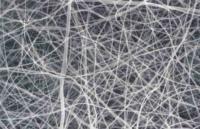
A scanning electron micrograph to illustrate the fibrous structure of the tube wall. The fibers are fewer than 500 nanometers in diameter, compared with the average hair shaft, which is 80,000-100,000 nanometers.Virginia Commonwealth University engineers and scientists have developed a new material that may one day help patients with damaged arteries regenerate new ones.
In the June issue of the journal Biomedical Materials, researchers reported the design and fabrication of a new material to be used for vascular grafts that in the future could ultimately be implanted in patients undergoing coronary artery graft surgery.
The material is a blend of polydioxanone (PDO), a synthetic biodegradable polymer that has been used in suture materials for years, and elastin fibers, used to enhance elasticity and bioactivity of the graft. Elastin, a natural polymer, is also a major component of the arterial wall and is critical to the graft in providing a base for the cells to recognize and interact with the body. Using a technique known as electrospinning, researchers were able to manipulate the PDO-elastin composite into a conduit, or hose, for use as a small diameter vascular graft.
"We have created a vascular graft with a combination of strength and bioactivity – two things we need to maintain and regenerate the graft. Although the body is the best bioreactor for tissue regeneration or wound healing, we hope this new material will be recognized by the body as an environment conducive for regeneration," said lead author Gary Bowlin, Ph.D., the Harris professor of biomedical engineering in the VCU School of Engineering.
According to Bowlin, the composition of the material reinforces the graft's mechanical strength, which is critical in order to hold the blood pressure and forces while the regeneration process is taking place. The PDO-elastin blend undergoes slow degradation and causes few adverse reactions compared with previous materials used for the same purpose, he said. The purpose of the new material would be to help a patient regenerate a new artery. If it works as designed the researchers hope that at six months post-surgery, there would be no more synthetic structure left, he said.
"Regeneration needs to be timed just right, and the cells regrowth needs to be strong enough so that the patient's own artery can take over for the synthetic material and promote regeneration," Bowlin said. "Additionally, the synthetic material must degrade, because any foreign material in the body for an extended time is susceptible to inflammatory response or even severe infection such as staphylococcus."
Bowlin and his colleagues are now evaluating how cells respond and interact with the different structures.
For more than 30 years, surgeons have used Teflon as a conduit or "artery" for such operations. Teflon is inert and once implanted in a patient, remains forever. However, this can lead to complications, especially in small diameter grafts in the arms, lower legs and coronary arteries. In addition, synthetic biodegradable polymers that are currently used may be adversely reactive and cause inflammatory responses, which degrades the materials faster and results in poor wound healing.
Source : Virginia Commonwealth University
 Print Article
Print Article Mail to a Friend
Mail to a Friend
